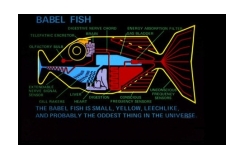How Close Are We to Creating A Bable Fish?

Posted on March 25, 2014 by Chris
There is an enduring fascination with online translation amongst software designers. Ever since The Hitchhikers’ Guide To The Galaxy, designers have wanted to make the imaginary Bable Fish a reality.
You will be familiar with Google Translate, which is fine for learning how to say ‘Goodnight’ in Swahili, but not much use if you need an important business document translated. Google translate is the leading software translation application, but it is seldom used by those who need their work to be accurate. The Google Chrome browse has built-in translation software, but again the results are patchy at best. So are there any new online translation applications in development and, more importantly, will they be any good?
Duolingo
Perhaps the most interesting development in online translation software is a project called Duolingo. The aim is to teach you a foreign language by allowing you to translate it into your native language. In the process of this exchange, the idea is that participants will translate the Internet in its entirety. Yes, you heard correctly. The whole of the Internet, one page at a time. That is the bold aim, and on paper it is a great idea. You learn a language, and the Internet is simultaneously translated for the world at large. But will it work?
Translate for Others
Duolingo works by feeding you a sentence in your target language, which will be pitched at your level. You translate it into your own language. It is as simple as that, and the developers proclaim that through this process “a wealth of language-shackled information will be liberated for all of humanity”. It is a lovely idea. The developers of Duolingo claim that if one million people took part in the exercise it would take them 80 hours to translate the whole of Wikipedia into Spanish. The benefit to you is that you learn a new language and expand your vocabulary. What could possibly go wrong?
Translation Needs Expertise
It seems doubtful that a system such as Duolingo will produce quality translations, simply because as language learners we are all at different stages, and likely to submit varying quality of translations of the text. How would a Chinese person translate a Spanish word with several meanings, some of which are depend on a specific culturally context? Which word would they use, and which would they use to follow it to add that all-important context? Duolingo is in beta testing, but those who have tried it give mixed reviews. Their reservations centre around the point that Network Languages always emphasise – to produce a good translation, there needs to be sophisticated cultural and colloquial familiarity with the target language.
Human vs. Machine Translation
Whilst software designers will always strive for the Holy Grail of the ‘Bable Fish’, the truth is it can never exist. All there is to be gained from machine translation are single words and short phrases, translated approximately from one language to another. There is no substitute for a highly trained professional translator, who is fluent in the source and target languages they are working on. There are very few shortcuts in translation work, and machines are certainly not one of them.




